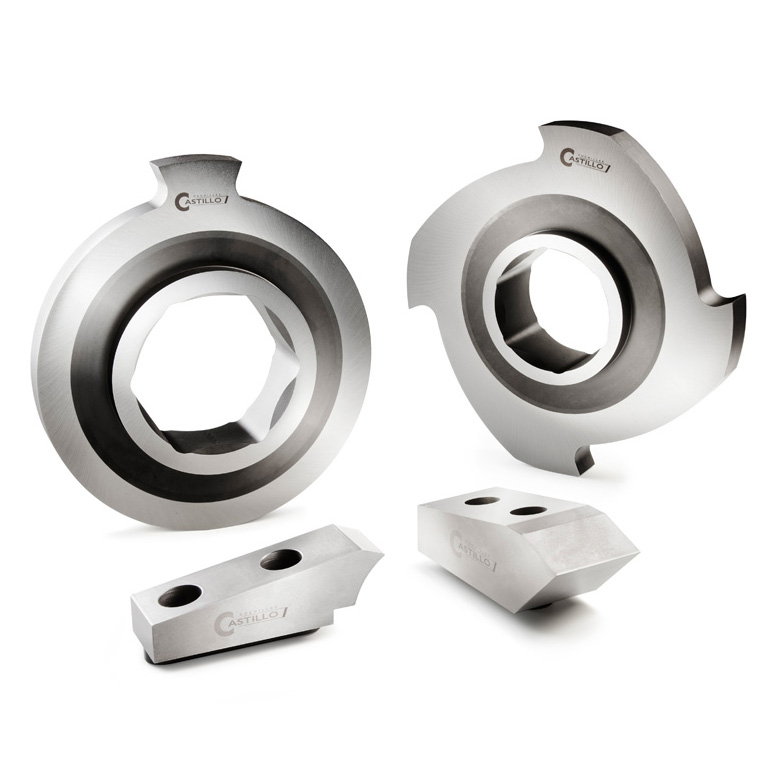The single-shaft shredders are essential tools for processing large amounts of waste materials, such as industrial waste, wood, plastics, rubber, tires, paper, agricultural waste, and even light metals like aluminum. At the heart of these machines are the blades, fundamental components whose quality and design directly impact efficiency and processing cycles.
In this article, we delve into the materials, designs, and features that make these blades an indispensable element in the recycling and waste processing industry, highlighting their crucial role in ensuring optimal and sustainable performance.
The Importance of Blades in Single-Shaft Shredders
Industrial blades are the central component that defines the functionality and efficiency of a single-shaft shredder. Without them, the process of breaking down waste materials would be ineffective and inconsistent. Their design and quality directly affect:
- Shredding Efficiency: Well-designed and sharpened blades ensure materials are cut uniformly, maximizing machine capacity and reducing processing time.
- Equipment Versatility: By adapting to various types of materials, from plastics and rubber to aluminum and wood, the blades expand the shredder’s application range.
- Durability and Maintenance: High-quality blades, made from hardened steels or specialized coatings, resist wear and tear, reducing the need for frequent replacements and minimizing operational costs.
- Final Product Quality: Clean and precise cuts facilitate subsequent processing, whether recycling, compacting, or disposal, ensuring materials meet the required standards.
At the core of recycling operations, these blades are essential for transforming bulky waste into manageable fragments, thereby promoting sustainability and the circular economy.
Main Features

Blades designed for single-shaft shredders stand out for their resistance, precision, and durability, essential characteristics for processing materials like wood, plastics, rubber, and agricultural waste. Unlike blades for two- and four-shaft shredders, which work together to break down materials through synchronized motion, single-shaft blades operate with a rotary design that cuts and fragments waste through a highly efficient process.
Main features of single-shaft shredder blades:
- Material Construction: Typically made of hardened steels or high-chromium steels, designed to withstand abrasion and wear during intensive use cycles.
- Edge Design: The blades feature straight or serrated edges, depending on the type of material being processed, ensuring precise and efficient cuts.
- Adaptability: They can be adjusted for different types of waste materials, from light metals to plastics and wood.
- Lower Complexity: Unlike two-shaft shredders, single-shaft models offer a simpler structure, making blade maintenance and replacement easier.
Single-Shaft vs. Two- and Four-Shaft Shredders: Key Differences

The choice between single-shaft, two-shaft, or four-shaft shredders depends on the type of material to be processed and the recycling or waste treatment objectives. Below are the main differences:
Single-Shaft Shredders:
- Operate with a single rotor that cuts materials against a fixed counter blade.
- Ideal for versatile applications and non-extremely compact materials.
- More economical and simpler in design, facilitating maintenance.
Two-Shaft Shredders:
- Equipped with two rotors that work in sync to cut tougher materials, such as metal scrap or large tires.
- Require blades with a more robust design to withstand the joint effort of the rotors.
Four-Shaft Shredders:
- Combine two main rotors with two secondary ones, optimizing size reduction and material separation.
- Used in applications requiring more thorough and uniform shredding, such as electronic waste or complex mixtures of plastics and metals.
Advantages of Blades for Single-Shaft Shredders
Blades designed for single-shaft shredders excel in offering:
- High Wear Resistance: Made from premium materials such as hardened steel, they ensure long life even under intensive use conditions.
- Clean and Uniform Cuts: Optimized edge designs ensure materials are processed efficiently to facilitate subsequent recycling or disposal.
- Reduced Operating Costs: Thanks to their simple structure, maintenance is more affordable compared to more complex systems.
Blade Materials for Single-Shaft Shredders
The choice of material for blades in single-shaft shredders is critical to ensure their resistance, durability, and efficiency under intensive use conditions. The materials used must withstand high levels of abrasion, continuous impacts, and the demanding processing cycles involving plastics, rubber, agricultural waste, and wood.
Main Materials Used:
- Hardened Steel: This material is the most common due to its balance between durability and wear resistance. Ideal for applications involving abrasive materials like reinforced plastics or rubber.
- High-Chromium Alloy Steels: Offer greater abrasion and wear resistance, especially useful in conditions where highly abrasive materials like aluminum or metal composites are processed.
- Tungsten Carbide: Used as a coating on the edges, it provides exceptional wear resistance, extending the blades’ lifespan in extreme-use applications.
- Stainless Steel: Although less common, it is employed in applications requiring corrosion resistance, such as processing wet agricultural waste.
Treatments and Coatings:
- Tempering and Annealing: Ensure greater hardness and mechanical resistance, prolonging the blades’ lifespan.
- Anti-Wear Coatings: Applications like tungsten carbide or advanced ceramics enhance performance under high-abrasion conditions.
Manufacturing Blades for Leading Brands
At Cuchillas Castillo, we manufacture blades for single-shaft shredders tailored to the specific needs of each client and application. Our expertise in the sector enables us to offer blades compatible with the leading shredder brands, including:
Amni, Bano, Barclay, BDR, BMH, CMG, Eldan, Enma, Forrec Recycling, Haas, Lindner, Miller, Molinari, MTB, Precimeca, Redoma, Reinbold, Stokkermill, TPA, Untha, Vecoplan, Wagner, Weima, Weis, Zeno, and Zerma.
We provide a wide range of steel grades and hardness levels, designed to maximize performance based on key factors like the nature and cleanliness of the plastic, material format, or machine condition. Additionally, our custom designs adapt the blades to specific applications, optimizing their lifespan and reducing operational costs.
Our commitment to quality extends to the thermal treatments and finishes we apply, ensuring superior resistance to wear and abrasion. This comprehensive approach positions us as a strategic partner for companies seeking reliable and durable solutions in waste material processing.
At Cuchillas Castillo, we design and manufacture industrial blades for single-shaft shredders, tailored to each client’s needs. Contact us and let our experts assist you.

